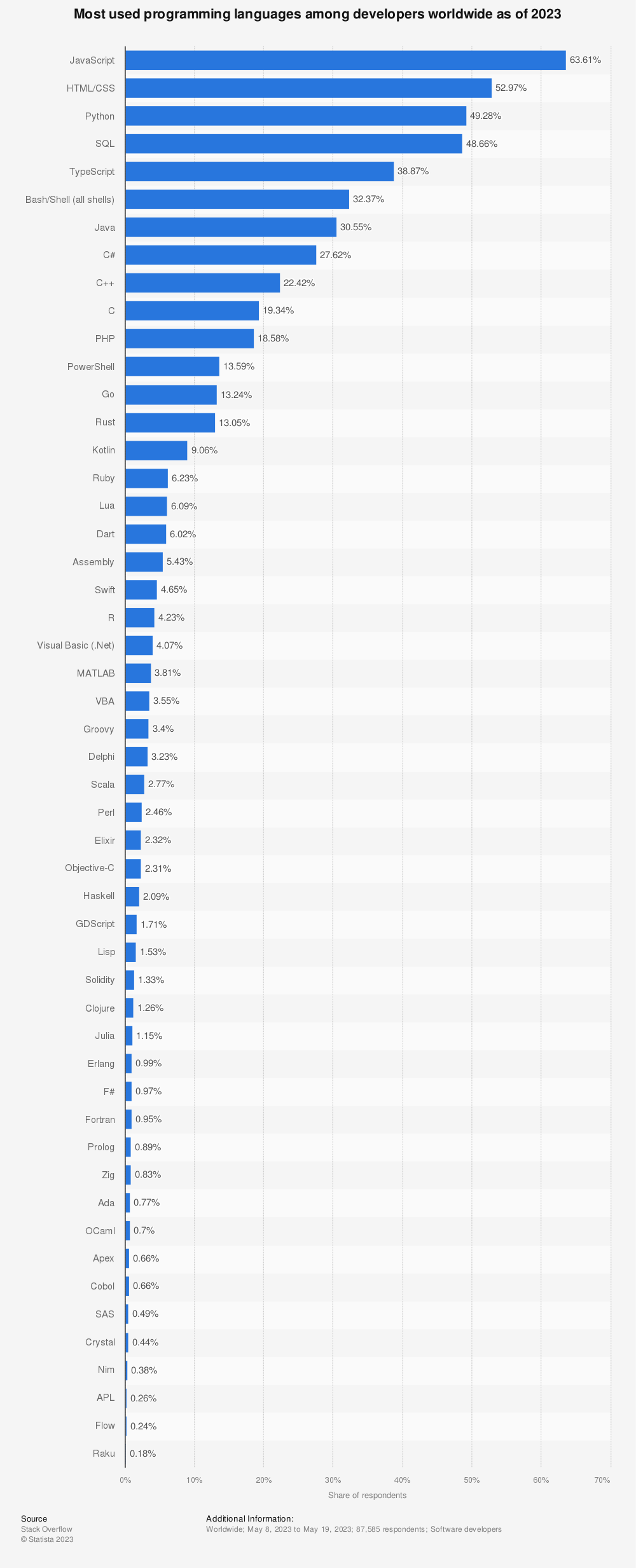So you want to know which language is predominantly used in software development, huh? Well, you’ve come to the right place! In this article, we will uncover the answer to this burning question and reveal the top programming languages that are dominating the software development industry. From the ever-popular Java to the versatile Python, we will explore the pros and cons of each language, giving you a comprehensive understanding of which one might be the best fit for your coding adventures. Whether you’re a seasoned developer or a coding newbie, this article will shed some light on the language that is ruling the realm of software development. So, let’s get started!
1. Introduction
When it comes to software development, choosing the right programming language is crucial. With so many options available, it can be overwhelming to determine which language is the best fit for your project. In this comprehensive article, we will explore the most popular programming languages in the industry, along with the factors that influence language choice. By the end, you’ll have a better understanding of the different languages and be equipped to make an informed decision.
2. Popular Programming Languages
2.1 Java
Java is a widely used programming language that has been around for decades. It is known for its stability, reliability, and platform independence. Java is often used for building enterprise-level applications, mobile apps, and large-scale systems. Its popularity can be attributed to its extensive libraries, strong community support, and compatibility with multiple platforms.
2.2 Python
Python is a versatile and beginner-friendly programming language that has gained significant popularity in recent years. Known for its simplicity and readability, Python is often used for web development, data analysis, artificial intelligence, and scientific computing. Its extensive collection of libraries and frameworks makes it a go-to choice for developers looking for quick prototyping and efficient development.
2.3 JavaScript
JavaScript is the backbone of web development, enabling interactive and dynamic website functionality. It is the only programming language supported by all major web browsers, making it an essential skill for front-end and full-stack developers. JavaScript is also increasingly used on the server-side with the rise of Node.js, allowing developers to build scalable and efficient web applications.
2.4 C++
C++ is a powerful and versatile programming language that is widely used for system-level programming and performance-critical applications. It offers low-level control, high performance, and a wide range of applications, including game development, embedded systems, and high-speed trading. C++ has a steep learning curve but provides unparalleled control and efficiency.
2.5 C#
C# (pronounced C sharp) is a modern, versatile programming language developed by Microsoft. It is primarily used for developing Windows applications, game development using Unity, and backend programming with the .NET framework. C# offers a balance between performance and ease of use, making it a popular choice for building robust and scalable applications.
2.6 Ruby
Ruby is a dynamic, object-oriented programming language with a focus on simplicity and productivity. It is often associated with web development using frameworks like Ruby on Rails. Ruby’s elegant syntax and community-driven nature attract developers who value readability and convention over configuration. It is known for promoting developer happiness and fast prototyping.
2.7 Swift
Swift is a relatively new programming language developed by Apple for iOS, macOS, watchOS, and tvOS application development. It is designed to be safe, expressive, and efficient. With its modern syntax and powerful features, Swift has quickly gained popularity among developers building applications for Apple’s platforms.
2.8 Go
Go, also known as Golang, is a programming language developed by Google. It is designed for simplicity, efficiency, and scalability, making it ideal for building large-scale distributed systems and web services. Go’s built-in concurrency and garbage collection features make it suitable for systems programming with a focus on performance and scalability.
2.9 Kotlin
Kotlin is a statically-typed programming language developed by JetBrains, the creators of IntelliJ IDEA. It is known for its interoperability with Java and Android development. Kotlin offers modern language features, null safety, and improved productivity, making it an attractive choice for Android app development.
2.10 TypeScript
TypeScript is a superset of JavaScript that introduces static typing and additional features to enhance developer productivity and code maintainability. It is often used in large-scale JavaScript applications to catch errors at compile-time, provide code documentation, and enable better tooling support. TypeScript can be transpiled into plain JavaScript, making it compatible with existing JavaScript ecosystems.
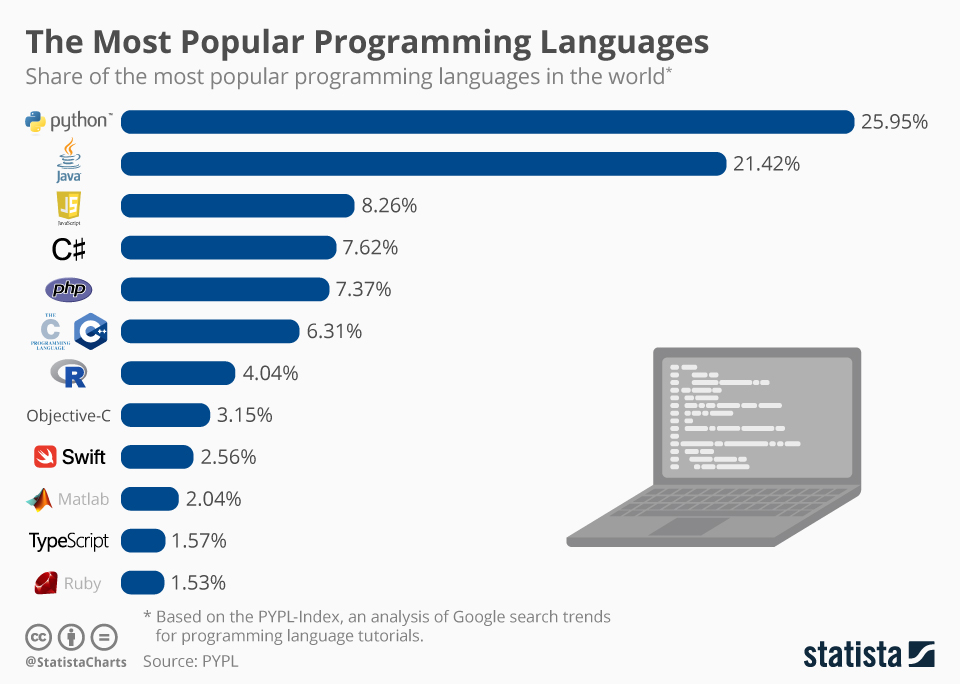
This image is property of cdn.statcdn.com.
3. Factors Influencing Language Choice
Choosing the right programming language for a software development project depends on several factors. Let’s explore some of the key considerations that influence language choice:
3.1 Platform Compatibility
Different programming languages are better suited for specific platforms. For example, if you’re developing an iOS app, languages like Swift or Objective-C would be the primary choices. Consider the target platform and ensure that the selected language has strong support and frameworks for that platform.
3.2 Performance and Efficiency
Performance and efficiency requirements play a crucial role in selecting a programming language. Languages like C++ and Rust excel in performance-critical applications, where low-level control and minimal overhead are essential. On the other hand, languages like Python prioritize developer productivity over raw performance.
3.3 Community and Support
A language’s community and support ecosystem can significantly impact developers’ experience and productivity. An active and helpful community means you’ll have access to resources, libraries, frameworks, and frequent updates. Consider the size and activity level of a language’s community before making a decision.
3.4 Learning Curve
The learning curve of a programming language can influence how quickly you can start developing with it. Some languages, like JavaScript and Python, have a gentle learning curve, making them suitable for beginners. Others, like C++ and Rust, have steeper learning curves due to their complexity and low-level nature.
3.5 Libraries and Frameworks
Languages with a rich ecosystem of libraries and frameworks can greatly simplify development tasks. Consider the availability and maturity of libraries and frameworks for the desired functionality. For example, if you’re building a web application, you may want to look for languages with established frameworks like Django (Python) or Ruby on Rails (Ruby).
3.6 Industry Demand
The demand for certain programming languages in the job market can influence your language choice. Languages like Java, Python, and JavaScript have a wide range of job opportunities across different industries. Research the job market and determine which languages are in high demand for positions that align with your career goals.
3.7 Personal Preference
Ultimately, personal preference plays a significant role in language choice. Each developer has their own preferences, strengths, and comfort levels with different programming paradigms. It’s essential to choose a language that you enjoy working with, as it can lead to higher productivity and job satisfaction.
4. Java
4.1 Overview
Java is a general-purpose, object-oriented programming language that was introduced by Sun Microsystems in the mid-1990s. It was designed to be platform-independent, allowing developers to write code once and run it on any system with a Java Virtual Machine (JVM). Java has a strong emphasis on readability, maintainability, and reliability.
4.2 Usage in Software Development
Java is widely used in various domains, including enterprise software development, Android app development, web applications, and data analysis. It is particularly popular for building scalable, robust, and secure enterprise-level applications due to its extensive libraries, frameworks, and rich ecosystem.
4.3 Advantages
- Platform independence: Java’s “write once, run anywhere” principle allows developers to build applications that can run on any platform with a compatible JVM.
- Large library ecosystem: Java has a vast collection of libraries and frameworks that provide ready-to-use functionality, reducing development time and effort.
- Strong community support: Java has a large and active community that contributes to its growth, provides assistance, and shares resources.
- Memory management: Java’s built-in garbage collection takes care of memory management, eliminating the need for developers to handle memory allocation and deallocation manually.
- Security: Java has built-in features for secure coding practices, making it a preferred choice for applications that deal with sensitive data.
4.4 Disadvantages
- Verbosity: Java’s syntax can be verbose compared to some other languages, which may lead to more code for achieving the same functionality.
- Steep learning curve: Java has a large language specification and numerous concepts to grasp, making it challenging for beginners compared to more beginner-friendly languages.
- Performance: While Java offers good performance in general, it may not be as efficient as low-level languages like C++ for certain performance-critical applications.
4.5 Popular Java Frameworks
- Spring Framework: A widely-used framework for building enterprise-level Java applications, providing dependency injection, transaction management, and robust MVC web development support.
- Hibernate: An object-relational mapping (ORM) framework for simplifying database access and persistence in Java applications.
- Apache Struts: A web application framework that facilitates the development of scalable and maintainable Java web applications.
- JavaServer Faces (JSF): A Java-based web application framework that simplifies building user interfaces for enterprise applications.
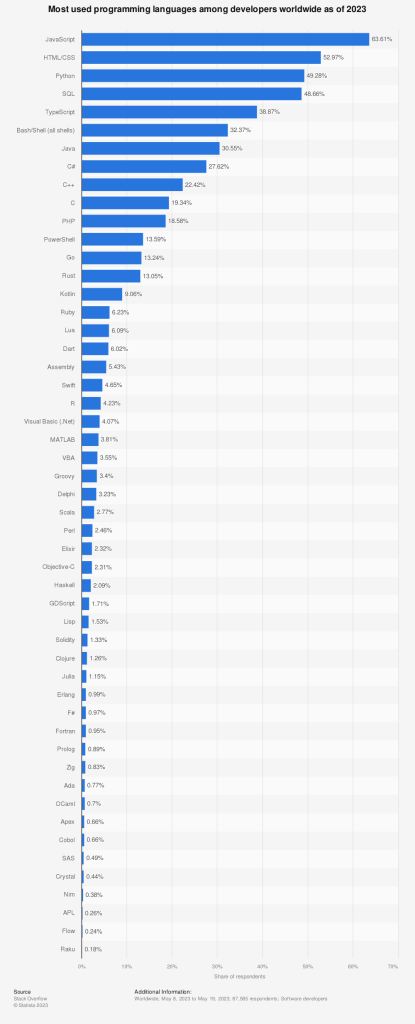
This image is property of www.statista.com.
5. Python
5.1 Overview
Python is a high-level, interpreted, and dynamically-typed programming language known for its simplicity and readability. It was created in the late 1980s by Guido van Rossum and has since become one of the most popular languages among developers.
5.2 Usage in Software Development
Python is widely used across diverse domains, including web development, data analysis, machine learning, artificial intelligence, scientific computing, and automation. Its versatility and robust standard library make it a go-to language for tasks ranging from quick scripts to large-scale applications.
5.3 Advantages
- Readability and simplicity: Python’s expressive syntax and clean design make it easy to read and write code, enhancing readability and reducing development time.
- Extensive standard library: Python’s extensive standard library provides a wide range of modules and packages for common tasks, eliminating the need to reinvent the wheel.
- Rapid prototyping: Python’s simplicity and productivity make it an excellent choice for quick prototyping and iterative development.
- Strong community support: Python has a large, active community that contributes to its growth, provides numerous libraries, frameworks, and resources, and offers help and support to developers.
5.4 Disadvantages
- Performance: Python’s interpreted nature can result in slower execution compared to compiled languages like C++. However, Python provides easy integration with performance-critical libraries written in other languages, mitigating this disadvantage.
- Global interpreter lock (GIL): Python’s GIL can limit the ability to achieve true parallelism in certain multi-threaded applications.
- Mobile app development: While Python can be used for mobile app development, it is less commonly used compared to languages like Java and Swift.
5.5 Popular Python Frameworks
- Django: A high-level web framework known for its ease of use, scalability, and robustness, making it ideal for building complex web applications.
- Flask: A lightweight and flexible framework that simplifies web development by providing essential components while allowing developers to choose additional libraries according to their needs.
- NumPy: A fundamental library for numerical computing in Python, providing high-performance multidimensional arrays and a wide range of mathematical functions.
- Pandas: A library that provides fast, flexible, and expressive data structures for data analysis, manipulation, and cleaning.
- TensorFlow: An open-source library for machine learning and deep learning, widely used for tasks like image recognition, natural language processing, and neural networks.
6. JavaScript
6.1 Overview
JavaScript is a versatile and widely-used programming language primarily used for front-end and full-stack web development. It was created in the mid-1990s by Brendan Eich and has since evolved to become a ubiquitous language for building interactive web applications.
6.2 Usage in Software Development
JavaScript is integral to modern web development, enabling dynamic and interactive experiences for users. With the advent of frameworks like Node.js, JavaScript has extended its reach to server-side development, allowing developers to build scalable and efficient web applications.
6.3 Advantages
- Ubiquity: JavaScript is the only programming language natively supported by all major web browsers, allowing developers to build cross-browser compatible applications.
- Versatility: JavaScript can be used for both front-end and back-end development, enabling full-stack development with a single language.
- Rich ecosystem: JavaScript has a vast ecosystem of libraries, frameworks, and tools that streamline development tasks and provide solutions for various requirements.
- Asynchronous programming: JavaScript’s event-driven, non-blocking nature makes it ideal for building responsive and interactive web applications.
6.4 Disadvantages
- Browser inconsistencies: Different web browsers may interpret JavaScript code differently, leading to cross-browser compatibility challenges that need to be addressed.
- Security concerns: As JavaScript runs on the client-side, it is susceptible to various security vulnerabilities, such as cross-site scripting (XSS) attacks.
- Lack of typing: JavaScript is dynamically-typed, which can lead to potential runtime errors that may not be caught during development.
6.5 Popular JavaScript Frameworks
- React: A popular JavaScript library for building user interfaces, allowing developers to create reusable UI components and efficiently render views based on data changes.
- Angular: A comprehensive framework maintained by Google, providing a complete toolkit for building scalable web applications with dependency injection, two-way data binding, and a robust component-based structure.
- Vue.js: A progressive JavaScript framework known for its simplicity and ease of integration, offering features like declarative rendering, component-based architecture, and reactive data binding.
- Express.js: A minimalistic and flexible web application framework that simplifies back-end development with Node.js, providing essential tools for building APIs and web servers.
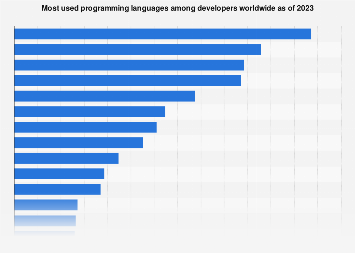
This image is property of cdn.statcdn.com.
7. C++
7.1 Overview
C++ is a powerful and versatile programming language derived from the C programming language. It was developed in the early 1980s by Bjarne Stroustrup. C++ combines procedural, object-oriented, and generic programming paradigms, offering low-level control and high performance.
7.2 Usage in Software Development
C++ is commonly used for system-level programming, where performance, control, and efficiency are paramount. It finds applications in areas such as game development, embedded systems, operating systems, and high-speed trading, where speed and memory management are critical.
7.3 Advantages
- Performance: C++ provides low-level control over hardware resources, allowing developers to write code that executes efficiently and takes advantage of a system’s capabilities.
- Memory management: C++ gives the programmer fine-grained control over memory allocation and deallocation, resulting in efficient resource utilization.
- Cross-platform compatibility: C++ code can be compiled and run on various platforms, making it suitable for software development across different operating systems.
7.4 Disadvantages
- Learning curve: C++ has a steep learning curve due to its complex syntax, memory management, and low-level concepts, which can make it challenging for beginners.
- Code complexity: Writing C++ code requires attention to detail and a thorough understanding of language features, as even small mistakes can lead to complex bugs and memory leaks.
- Development time: Building software with C++ can take longer compared to higher-level languages, as it requires more manual memory management and boilerplate code.
7.5 Popular C++ Frameworks
- Qt: A cross-platform application development framework that simplifies the creation of graphical user interfaces, enabling developers to build desktop and mobile applications efficiently.
- Boost: A comprehensive collection of libraries that extends the capabilities of the C++ Standard Library, providing additional functionality for tasks like string manipulation, multithreading, and data structures.
8. C#
8.1 Overview
C# (pronounced C sharp) is a modern, object-oriented programming language developed by Microsoft. It was introduced in the early 2000s as part of the .NET framework and has since become a prominent language for Windows application development.
8.2 Usage in Software Development
C# is primarily used for developing Windows applications, web applications using ASP.NET, game development using the Unity game engine, and backend programming with the .NET framework. Its syntax is similar to that of Java, making it easy for Java developers to transition to C#.
8.3 Advantages
- Integration with .NET framework: C# is tightly integrated with the .NET framework, allowing developers to leverage its extensive libraries, tools, and APIs for building Windows applications and web services.
- Language features: C# offers modern language features like generics, LINQ, async/await, and lambda expressions, enhancing programmer productivity and code expressiveness.
- Performance: C# provides high performance on the .NET platform and can handle complex applications with good memory management and garbage collection.
8.4 Disadvantages
- Platform dependence: While C# is used primarily for Windows application development, it is not as portable as languages like Java or Python. However, there are cross-platform frameworks like Xamarin that enable C# development on other platforms.
- Learning curve: While C#’s syntax is similar to Java, it still requires learning and understanding the intricacies of the .NET framework and related development tools.
8.5 Popular C# Frameworks
- ASP.NET: A web application framework for building scalable and secure web applications and APIs using C#, providing a model-view-controller (MVC) architecture and powerful tools for authentication, authorization, and data access.
- Entity Framework: A popular Object-Relational Mapping (ORM) framework that simplifies database access and data manipulation, allowing developers to interact with databases using C# objects.
- Unity: A widely-used game development engine that uses C# as its primary scripting language, enabling developers to build games for various platforms, including PC, consoles, and mobile devices.
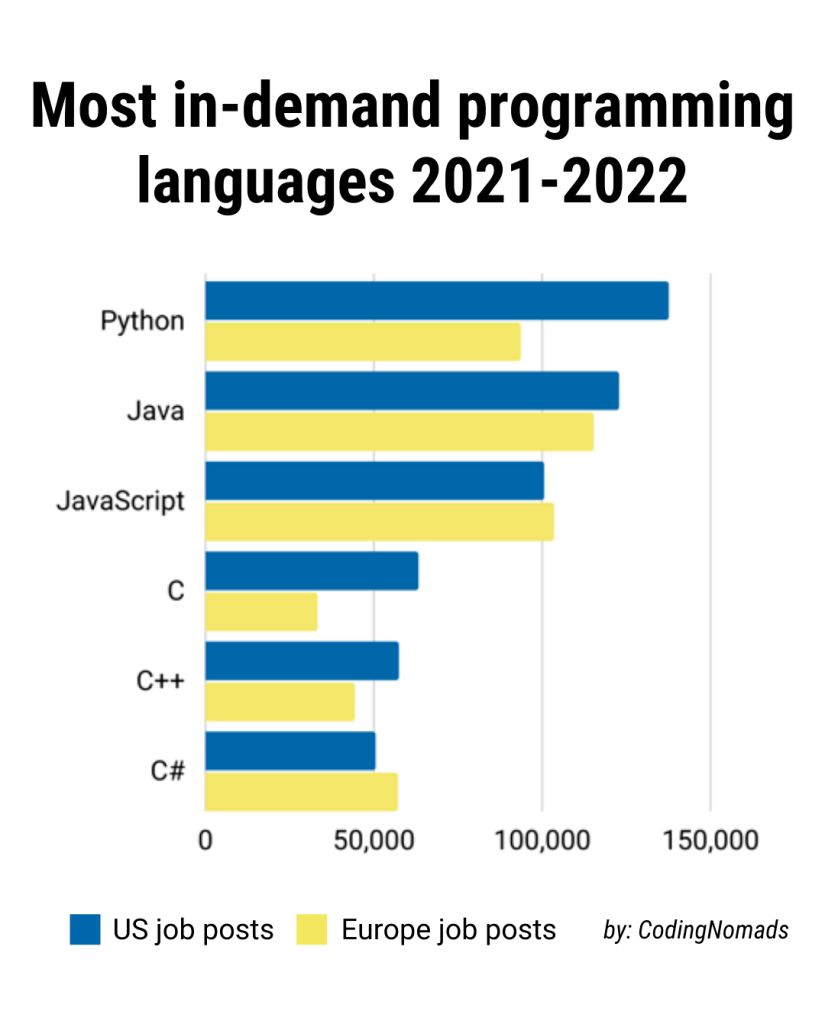
This image is property of www.elluminatiinc.com.
9. Ruby
9.1 Overview
Ruby is a dynamic, object-oriented programming language known for its simplicity and productivity. It was created in the mid-1990s by Yukihiro Matsumoto and gained popularity with the advent of the Ruby on Rails web development framework.
9.2 Usage in Software Development
Ruby is often used for web development, particularly with the Ruby on Rails framework. It emphasizes convention over configuration, reducing boilerplate code and enabling developers to build web applications rapidly. Ruby’s flexibility and elegant syntax also make it suitable for scripting, automation, and rapid prototyping.
9.3 Advantages
- Elegant syntax: Ruby’s syntax is designed to be human-readable and expressive, promoting developer happiness and productivity.
- Developer-friendly: Ruby’s focus on convention over configuration and principle of least surprise enables developers to write code quickly and intuitively.
- Active community: Ruby has a passionate and helpful community that contributes to the development of libraries, frameworks, and resources, making it a welcoming language for beginners.
9.4 Disadvantages
- Performance: Ruby’s performance is comparatively slower compared to some other languages, which may limit its suitability for performance-critical applications.
- Limited scalability: Ruby’s performance overhead and memory usage may impact scalability for handling high-volume traffic or data-intensive applications.
- Learning curve for Rails: While Ruby itself has a gentle learning curve, learning the Ruby on Rails framework can require additional effort due to its conventions and best practices.
9.5 Popular Ruby Frameworks
- Ruby on Rails: A powerful and popular framework for building web applications, providing a model-view-controller (MVC) architecture, database integration, and automated scaffolding.
- Sinatra: A minimalist web application framework that emphasizes simplicity, making it suitable for building lightweight web services and APIs.
- Hanami: A modern web application framework that promotes modularity, stability, and performance, providing a range of features for building scalable web applications.
14. Conclusion
Choosing the right programming language for software development is a critical decision that can impact the success of your project. In this comprehensive article, we explored the most popular programming languages, including Java, Python, JavaScript, C++, C#, Ruby, and more. Factors like platform compatibility, performance, community support, learning curve, libraries, industry demand, and personal preference should be taken into account when making a language choice.
Java, with its platform independence and extensive libraries, is well-suited for enterprise-level development. Python’s readability, versatility, and robust ecosystem make it a go-to language for various domains, including web development and data analysis. JavaScript, the backbone of web development, enables interactive and dynamic web experiences. C++ offers low-level control and high performance, making it ideal for system-level programming. C# is widely used for Windows application development and backend programming with the .NET framework. Ruby’s elegant syntax, convention over configuration approach, and productivity-focused ecosystem make it popular for web development. Ultimately, the choice of programming language should align with project requirements, target platforms, performance needs, and personal preferences.
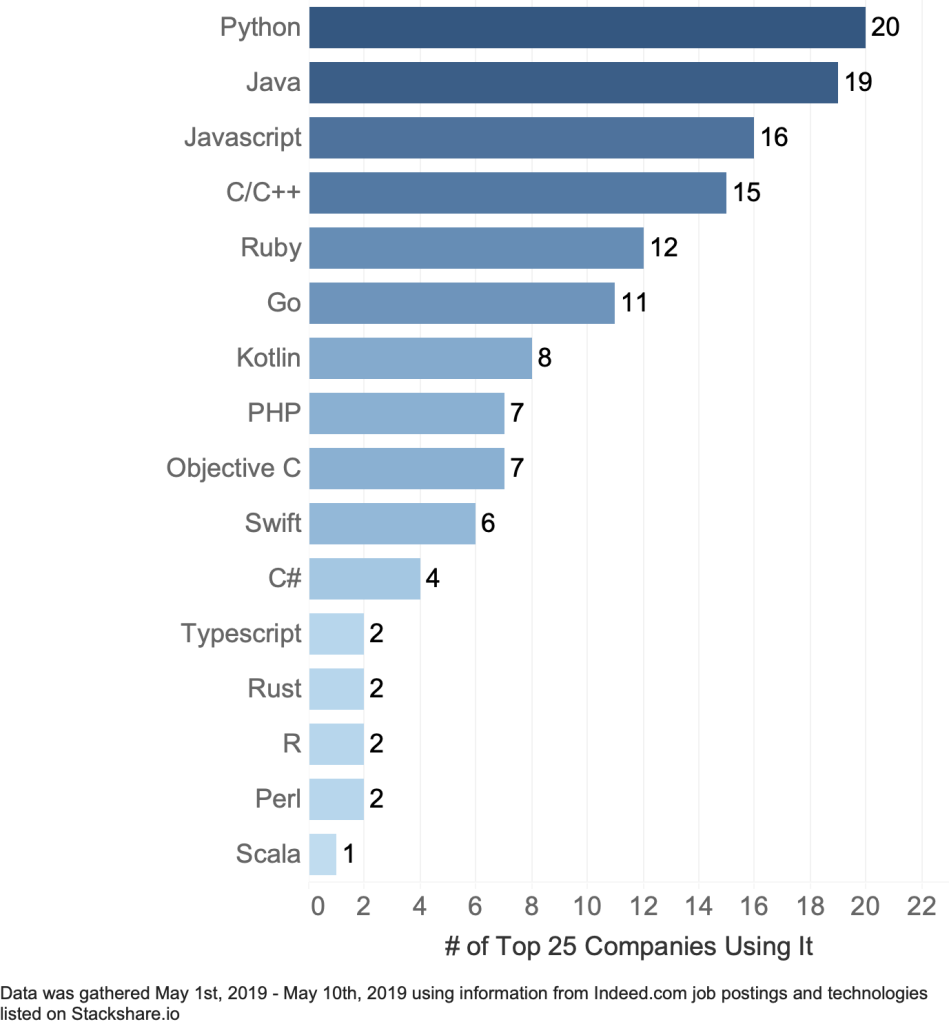
This image is property of www.codingdojo.com.
